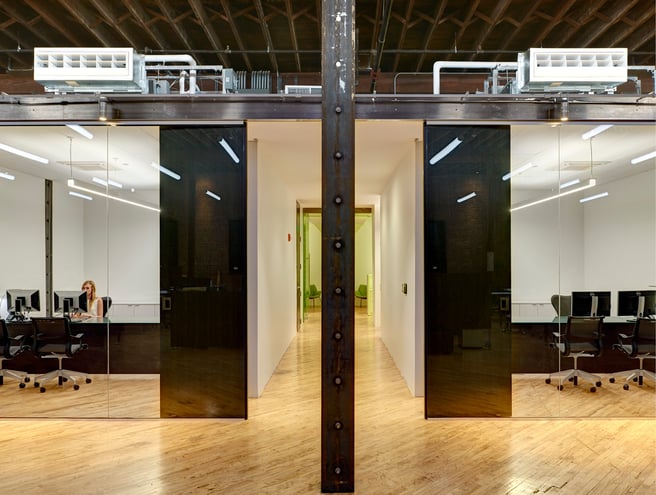What is Energy Use Intensity, and How Does it Impact Your Project?

A building project is an opportunity to reduce your energy consumption. Whether you construct a new facility or renovate an existing one, you can expect to discuss energy performance and utility costs with your design team.
In these conversations, you may hear the term Energy Use Intensity (EUI). Throughout the design process, your team will use energy modeling to predict your building’s EUI and work to get the number as low as possible. Since EUI is central to every building project, it helps to familiarize yourself with the term.
In this article, you will learn how EUI is calculated and the best practices for improving it. You will also learn how your design team will help you balance energy performance with costs and occupant comfort.
What is Energy Use Intensity?
Energy Use Intensity (EUI) refers to the amount of energy used per square foot annually. It’s calculated by dividing the total energy consumed by the building in a year by the total gross floor area. Like miles per gallon for cars, EUI is the prime indicator of a building’s energy performance.
Site vs. Source EUI
There are two types of EUI: site and source. Site EUI is the amount of energy consumed on the building site, while Source EUI traces energy use back to the power plant and measures the amount of raw energy used to operate the building.
On most projects, your design team will focus on Site EUI. Calculating Source EUI usually requires the help of a third party and is only done in special cases, like projects with ambitious sustainability goals.
EUI by Building Type
While code requirements specify a base-level EUI, numbers differ across building types. Hospitals, labs, and data centers tend to have a higher EUI due to equipment and hours of operation. Schools, in comparison, have a lower EUI due to shorter hours and summer breaks.
What Are the Best Practices for Improving EUI?
Although EUI differs across building types, every project benefits from design decisions that improve energy performance. Throughout the design process, your architect will use energy-modeling software to predict EUI and test options.
High-level, early planning has the greatest impact on a building’s EUI. For new buildings, your architect will test options for massing (the building’s shape) and solar orientation (the direction of the building relative to the sun). Your architect can also assist with site selection and help you find a location optimal for building orientation.
In addition to massing and orientation, smaller-scale decisions also impact EUI. Your architect should model options and help you make decisions related to:
- Mechanical systems
- Electrical systems
- Insulation
- Glazing
- Appliances and equipment
There is no one-size-fits-all approach for improving EUI. The best solution depends on your local climate and project specifications.

Mechanical system improvements can help lower EUI.
How Do You Balance Energy Performance with Cost and Comfort?
Although energy performance is important, there are many factors to consider when making design decisions. Energy performance should be balanced with initial costs and occupant comfort. Your architect should help you weigh the pros and cons of each decision.
Operational Costs
Generally, your architect will discuss initial or capital costs and lifecycle or long-term costs. While many energy-efficient systems have a higher initial cost, they provide a long-term return on investment. For example, you may pay more upfront for a highly efficient mechanical system, but you will likely make up the cost over time through energy savings.
By analyzing the payback of each investment, your architect can help you get the most out of your budget.
Some building types, like schools, are required by code to circulate air more frequently than other types. Extra insulation will not likely provide a return on investment, because it will not prevent the mechanical system from running. Instead, it makes more sense to invest in mechanical system improvements.
Occupant Comfort
Your architect should also help you find solutions that improve occupant comfort. An energy-efficient building falls short of its potential if it does not meet occupants’ needs.
Some design decisions may not offer a significant financial payback, but they benefit occupants. As mentioned, some building types may not receive a payback on extra insulation or window glazing due to air exchange requirements. However, an investment in better glazing will make it more comfortable to sit by the windows.
If occupants are comfortable, they are less likely to adjust the thermostat. The financial impact of the additional investment in better glazing can be hard to calculate, but it is still worthwhile.
Learn More About Sustainable Design
Energy performance is central to every building project. High-level, early planning is the best way to improve EUI. By testing options for massing and solar orientation, you can create efficiencies and reduce your long-term energy costs. You should also test options for mechanical systems, electrical systems, insulation, and more.
Energy performance should be balanced with cost and thermal comfort. A balanced approach will help you achieve a building that serves occupants and provides you with a financial return on investment.
One of the most effective ways to improve your performance is by utilizing a third-party building verification system. Learn more by reading about the most popular systems on the market.